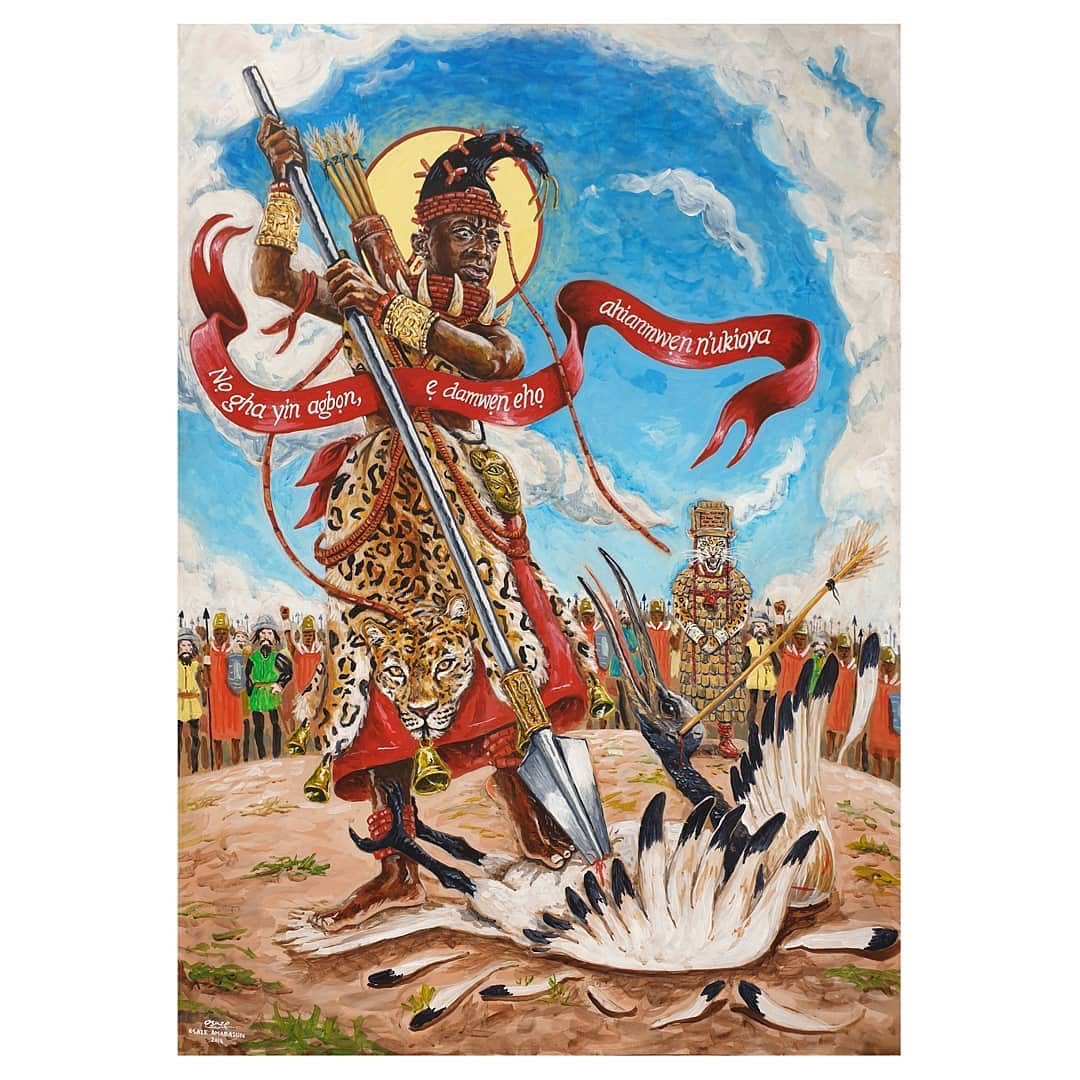Ahianmwẹ-Ọrọ, which means “bird of prophecy” in English, is a long-beaked bird whose call is considered prophetic. If he shouts “OyaO” (shame), it indicates danger or disaster. When he shouts “Oliguegue” (be grateful), it means good favour, luck or happiness. If he constantly shouts “OyaO, OyaO” in front of someone, it means that the person should be careful and not go on a journey or return home instead of continuing the journey. But if the bird continues to call “Oliguegue,” the journey will be successful.The bird is believed to be a messenger from the spirit world.

When Ọba Ẹsigie entered the gates of Benin in 1515 to fight against Attah of Idah, Ahianmwẹ-Ọrọ uttered the discouraging sounds “OyaO, OyaO” above his head, heralding the impending catastrophe. Ọba ordered the bird to be killed and won the war. He said, “Nẹ O gha yin Agbon, ghẹi daho Ahianmwẹ notoẹ oya” (Whoever wants to be successful in life should not pay attention to the bird of prophecy).
After his triumphant return from battle, Ọba commissioned Igun-Eronmwon to create the image of a bird on the bronze head of a battle standard to remind him that Ọba was not subject to the fate of ordinary spirits. Ahianmwẹ-Ọrọ is used to describe prophetic bird staffs and prophetic bird figures. The bird staffs of prophecy are a type of idiophone or musical instrument. Although the depiction of the bird sitting on these sticks varies, it is considered Ahianmwẹ-Ọrọ.
The Beninese soldiers thought that the bird warned of impending defeat, but the Oba said: “Ne o yha yin agbon, i danmwe eho ahianmwen no tie oyao,” i.e. H.A person who wants to live on this earth does not listen to the bird that calls “shame”. Oba Esigie wins the war and orders the brasssmiths to fire the bird with its long beak.
During the Ugie Oro-Oro festival, Oba Esigie asked his leaders to help him beat the beak with which the bird scremed shame (Oyao) to lure it into war. The prophetic bird existed because some of the ancient bronze plaques that once adorned the rafters of the Oba Palace in Benin depict musicians, chiefs playing the percussion idiophone Ahianmwe-Oro. (Not Ia vbe egogo) the bell rings.
Many very old Ahianmwe gold brass bars were also found in the capital of Benin after the British conquest, while some looted Ahianmwe gold brass bars are privately owned and can be found in the Metropolitan Museum. In addition to chopsticks, the Edo also use bells and slit drums.
The prophetic bird of good and bad signs can still be heard calling Oliguegue: Be grateful; but a foolish man hears the cry of Oyao – disgrace, while wise men are courageous. Cast in bronze, the prophetic bird is the standard carried into battle by Beninese warriors, and its beak is struck as an idiophonic percussion in Beninese culture in memory of its shameful and ignominious prophecy during the triumphant victory festival of Oro-Ugie oro.
These sticks are used during the annual Ugie Oro, when chiefs strike the bird’s beak to celebrate Benin’s victory and the continuation of Oba rule. These pipes are cast from brass or, in rarer cases, carved from ivory; prophetic bird figures are cast from brass or bronze. Their exact purpose is unclear, although it is possible that they were used on altars or shrines.
Oba Esigie creates the Gold Festival (Ugie Oro) to commemorate the great internal and external wars. Ugie Oro is celebrated every five days for three months. The king and chiefs dance in a procession in full dress. It is believed to be such an attractive festival that, as a Beninese proverb says, “If a farmer takes part in the gold dance, the farmer will never take care of his farm.
As part of the ceremony, the chiefs dance in a circle and strike the beak of a prophetic bird made of cast brass with a stick, in memory of the prophetic bird that Oba Esigie killed on his way to victory over the Igala people.The chiefs carry a standard staff and strike the bow with a brass rod to commemorate its nefarious prophecy, hence the name Ahianmwe-Oro, a copper rod used during the Oro festival.
There are indeed similarities between Oba Esigie and Oba Eresonyen, both of whom overcame serious internal opposition. Brass foundry thrives under every kingdom. Esigi’s imitation was clearly reminiscent of a time when the kingdom was at its peak and ruled by a wealthy monarch of undeniably legitimate origins.
Just as Oba Esigie introduced a new ritual into the annual cycle, Ugie Oro – the festival of gold, Oba Eresoyen introduced Ugie Ododua.Ododui artists, on the other hand, wear brass masks in the form of helmets.
Bronze casting of the head of Ahianmwe – Oro, the prophetic bird, is a drumstick idiophone used only by the Benin people. Percussion idiophones are made of brass in the shape of a bird with a long beak and are struck with a brass mallet in the beak.
The bird-shaped wand is called Ahianmwe – Oro, which means “Oro Bird Festival”. The Oro Festival takes place in May/June in Uki Eghe, the lunar month.And Ahianmwe Oro is only used during the Oro-Ugie-Oro festival.
Only the Obas and some chiefs sound on the pentagram. According to tradition, Ugie Oro was invented by Oba Esigie in the early 16th century.
A prophetic bird with a very long beak is said to have shouted “Oyao,” meaning “shame,” as Oba Esigie marched towards Idah with his army.

